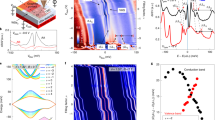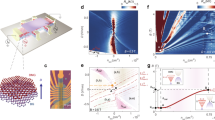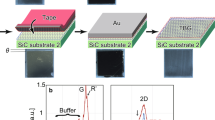Abstract
A striking feature of bilayer graphene is the induction of a significant band gap in the electronic states by the application of a perpendicular electric field1,2,3,4,5,6,7. Thicker graphene layers are also highly attractive materials. The ability to produce a band gap in these systems is of great fundamental and practical interest. Both experimental8 and theoretical9,10,11,12,13,14,15,16 investigations of graphene trilayers with the typical ABA layer stacking have, however, revealed the lack of any appreciable induced gap. Here we contrast this behaviour with that exhibited by graphene trilayers with ABC crystallographic stacking. The symmetry of this structure is similar to that of AB-stacked graphene bilayers and, as shown by infrared conductivity measurements, permits a large band gap to be formed by an applied electric field. Our results demonstrate the critical and hitherto neglected role of the crystallographic stacking sequence on the induction of a band gap in few-layer graphene.
This is a preview of subscription content, access via your institution
Access options
Subscribe to this journal
Receive 12 print issues and online access
269,00 € per year
only 22,42 € per issue
Buy this article
- Purchase on SpringerLink
- Instant access to full article PDF
Prices may be subject to local taxes which are calculated during checkout



Similar content being viewed by others
References
Ohta, T., Bostwick, A., Seyller, T., Horn, K. & Rotenberg, E. Controlling the electronic structure of bilayer graphene. Science 313, 951–954 (2006).
Castro, E. V. et al. Biased bilayer graphene: Semiconductor with a gap tunable by the electric field effect. Phys. Rev. Lett. 99, 216802 (2007).
Oostinga, J. B., Heersche, H. B., Liu, X. L., Morpurgo, A. F. & Vandersypen, L. M. K. Gate-induced insulating state in bilayer graphene devices. Nature Mater. 7, 151–157 (2008).
Zhang, Y. B. et al. Direct observation of a widely tunable bandgap in bilayer graphene. Nature 459, 820–823 (2009).
Mak, K. F., Lui, C. H., Shan, J. & Heinz, T. F. Observation of an electric-field-induced band gap in bilayer graphene by infrared spectroscopy. Phys. Rev. Lett. 102, 256405 (2009).
Kuzmenko, A. B., Crassee, I., van der Marel, D., Blake, P. & Novoselov, K. S. Determination of the gate-tunable band gap and tight-binding parameters in bilayer graphene using infrared spectroscopy. Phys. Rev. B 80, 165406 (2009).
Xia, F. N., Farmer, D. B., Lin, Y. M. & Avouris, P. Graphene field-effect transistors with high on/off current ratio and large transport band gap at room temperature. Nano Lett. 10, 715–718 (2010).
Craciun, M. F. et al. Trilayer graphene is a semimetal with a gate-tunable band overlap. Nature Nanotech. 4, 383–388 (2009).
Guinea, F., Neto, A. H. C. & Peres, N. M. R. Electronic states and Landau levels in graphene stacks. Phys. Rev. B 73, 245426 (2006).
Aoki, M. & Amawashi, H. Dependence of band structures on stacking and field in layered graphene. Solid State Commun. 142, 123–127 (2007).
Avetisyan, A. A., Partoens, B. & Peeters, F. M. Electric field tuning of the band gap in graphene multilayers. Phys. Rev. B 79, 035421 (2009).
Avetisyan, A. A., Partoens, B. & Peeters, F. M. Electric-field control of the band gap and Fermi energy in graphene multilayers by top and back gates. Phys. Rev. B 80, 195401 (2009).
Koshino, M. Interlayer screening effect in graphene multilayers with ABA and ABC stacking. Phys. Rev. B 81, 125304 (2010).
Kumar, S. B. & Guo, J. Multilayer graphene under vertical electric field. Appl. Phys. Lett. 98, 222101 (2011).
Wu, B. R. Field modulation of the electronic structure of trilayer graphene. Appl. Phys. Lett. 98, 263107 (2011).
Tang, K. et al. Electric-field-induced energy gap in few-layer graphene. J. Phys. Chem. C 115, 9458–9464 (2011).
Zhou, S. Y. et al. Substrate-induced bandgap opening in epitaxial graphene. Nature Mater. 6, 916 (2007).
Balog, R. et al. Bandgap opening in graphene induced by patterned hydrogen adsorption. Nature Mater. 9, 315–319 (2010).
Latil, S. & Henrard, L. Charge carriers in few-layer graphene films. Phys. Rev. Lett. 97, 036803 (2006).
Min, H. K. & MacDonald, A. H. Electronic structure of multilayer graphene. Prog. Theor. Phys. Suppl. 176, 227–252 (2008).
Avetisyan, A. A., Partoens, B. & Peeters, F. M. Stacking order dependent electric field tuning of the band gap in graphene multilayers. Phys. Rev. B 81, 115432 (2010).
Zhang, F., Sahu, B., Min, H. & MacDonald, A. H. Band structure of ABC -stacked graphene trilayers. Phys. Rev. B 82, 035409 (2010).
Koshino, M. & McCann, E. Gate-induced interlayer asymmetry in ABA-stacked trilayer graphene. Phys. Rev. B 79, 125443 (2009).
Mak, K. F., Shan, J. & Heinz, T. F. Electronic structure of few-layer graphene: Experimental demonstration of strong dependence on stacking sequence. Phys. Rev. Lett. 104, 176404 (2010).
Lui, C. H. et al. Imaging stacking order in few-layer graphene. Nano Lett. 11, 164–169 (2010).
Mak, K. F., Sfeir, M. Y., Misewich, J. A. & Heinz, T. F. The evolution of electronic structure in few-layer graphene revealed by optical spectroscopy. Proc. Natl Acad. Sci. USA 107, 14999 (2010).
Mak, K. F. et al. Measurement of the optical conductivity of graphene. Phys. Rev. Lett. 101, 196405 (2008).
Li, Z. Q. et al. Band structure asymmetry of bilayer graphene revealed by infrared spectroscopy. Phys. Rev. Lett. 102, 037403 (2009).
Kuzmenko, A. B. et al. Infrared spectroscopy of electronic bands in bilayer graphene. Phys. Rev. B 79, 115441 (2009).
Norimatsu, W. & Kusunoki, M. Selective formation of ABC-stacked graphene layers on SiC(0001). Phys. Rev. B 81, 161410 (2010).
Acknowledgements
We thank G. L. Carr and R. Smith for technical support in the infrared measurement at Brookhaven National Laboratory, D. Efetov for support in device fabrication, and A. A. Avetisyan, B. Partoens, F. M. Peeters, M. Koshino, and Y. L. Li for discussions. The authors acknowledge support from the Office of Naval Research under the MURI program for device preparation and from the US Department of Energy under Energy Frontier Research Center grant DE-SC0001085 for spectroscopic measurements and analysis. E.C. acknowledges support from the European FP7 Marie Curie project PIEF-GA-2009-251904.
Author information
Authors and Affiliations
Contributions
C.H.L. and Z.L. fabricated and characterized the samples, and carried out the measurements. K.F.M. led the design of the experiment and analysis methods. E.C., K.F.M. and C.H.L. developed the theoretical treatment and performed the simulations. All authors discussed the experiment and analysis. C.H.L. and T.F.H. wrote the manuscript.
Corresponding author
Ethics declarations
Competing interests
The authors declare no competing financial interests.
Supplementary information
Supplementary Information
Supplementary Information (PDF 446 kb)
Rights and permissions
About this article
Cite this article
Lui, C., Li, Z., Mak, K. et al. Observation of an electrically tunable band gap in trilayer graphene. Nature Phys 7, 944–947 (2011). https://doi.org/10.1038/nphys2102
Received:
Accepted:
Published:
Issue Date:
DOI: https://doi.org/10.1038/nphys2102
This article is cited by
-
Electric field tunable bandgap in twisted double trilayer graphene
npj 2D Materials and Applications (2024)
-
Ferroelectric and spontaneous quantum Hall states in intrinsic rhombohedral trilayer graphene
Nature Physics (2024)
-
Local atomic stacking and symmetry in twisted graphene trilayers
Nature Materials (2024)
-
Phonon thermal transport in bilayer polycrystalline graphene nanoribbons: effects of interlayer interaction, grain size, and vacancy defects
AAPPS Bulletin (2024)
-
Gate-controlled suppression of light-driven proton transport through graphene electrodes
Nature Communications (2023)



